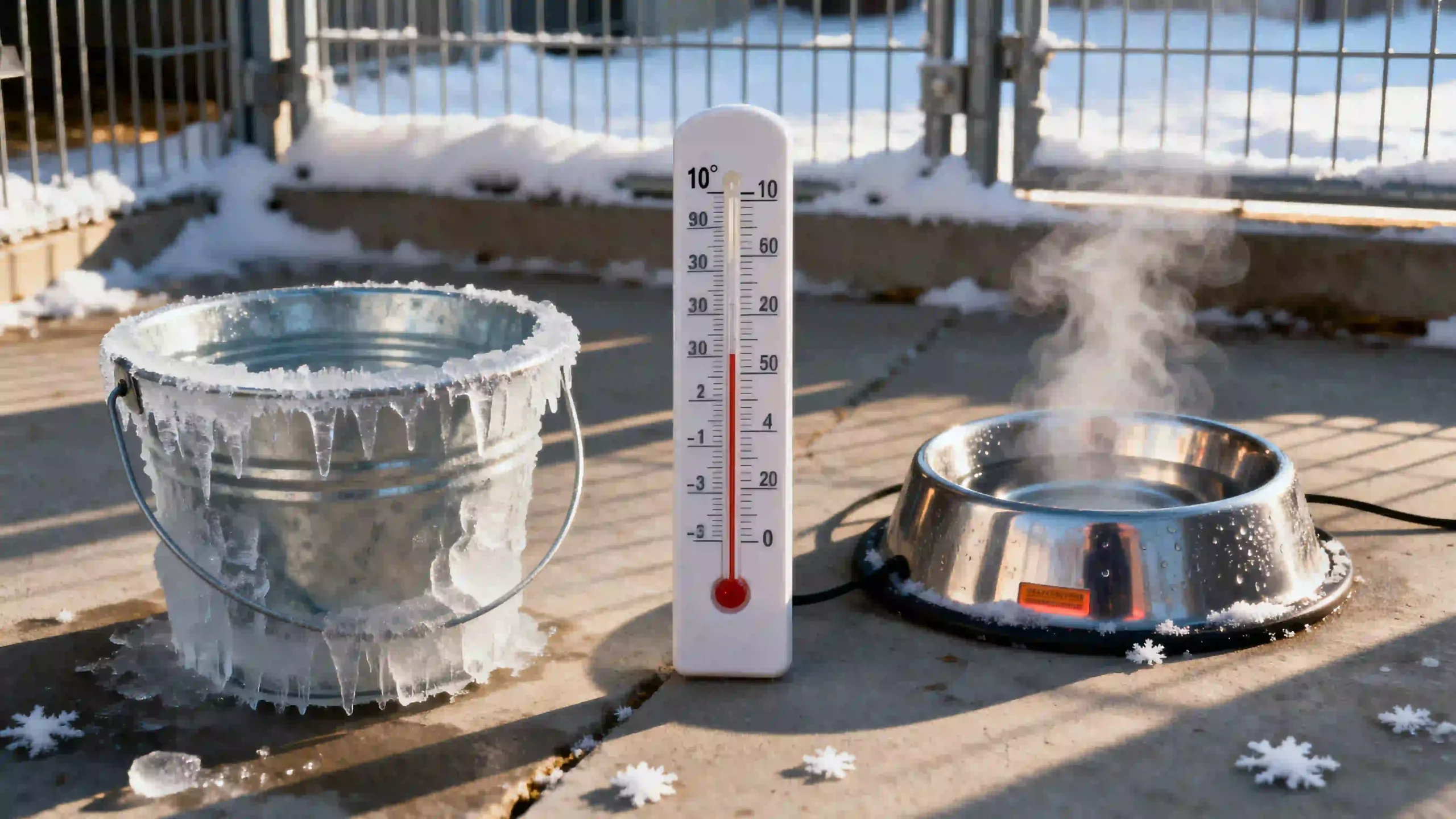When your kennel houses many dogs through harsh winters, scaling hydration is a major logistical challenge. The debate between using heated buckets versus heated dog bowls is not just about equipment—it’s about staff time, utility costs, durability, and animal care. This comparison will help you understand which approach (or which mix) works best for large kennels, especially in regions with long cold seasons.
What You’re Up Against in Winter Kennel Hydration
Large kennels deal with:
- Multiple dogs drinking nearly simultaneously.
- Freezing temperatures causing bowls/buckets to ice over—requiring frequent manual intervention.
- Safety & health issues—dogs may not drink enough if ice forms, or may ingest slush/bacteria.
- High maintenance labor for cleaning, replacing units,-monitoring heat sources.
All this affects kennel water systems staffing and budget planning.
Heated Bucket vs Heated Dog Bowl: Key Differences
| Aspect | Heated Buckets | Heated Dog Bowls |
|---|---|---|
| Water capacity & freeze resistance | Buckets hold many gallons, larger thermal mass delays freezing. Good for overnight or low-staff shifts. | Bowls freeze faster due to smaller volume; more frequent refills needed unless heated and insulated properly. |
| Energy & heating requirements | Higher wattage or de-icer discs needed; heat element must cope with large volume and wider exposed surface. | Lower wattage per unit; heating element works more efficiently on smaller volumes; less energy wasted if insulated. |
| Cleaning & maintenance | Bigger size makes cleaning tougher; sludge or algae in large bodies of water accumulates; buckets need draining and deeper cleaning. | Easier to clean; easier to remove, sanitize; more manageable for staff. |
| Installation complexity & space | More space & strong structural support needed; may need bucket heaters or discs; may need elevated platforms. | More flexible placement; bowls can go in individual runs, sheltered or mounted. |
| Cost & replacement | Larger upfront cost; replacements heavier; parts more expensive. | Cheaper per unit; spares more accessible; replacements simpler. |
| Suitability for multi-dog scenarios | Good for feeding a group or large run; if dogs share water source, a large bucket may suffice. | Better when dogs are separated or have individual runs—multiple bowls needed for sharing same accessibility. |
When a Heated Bucket Might Make Sense
A few use-cases where heated buckets outperform bowls in large kennels:
- Large outdoor runs or free-runs where many dogs use a shared water source; you want to minimize trips to refill.
- Low staffing periods (overnight or early morning)—you want water still liquid until someone can check.
- Very cold extreme weather—the thermal mass of buckets helps buffer sudden temp drops.
- Facilities with ability to install heavy duty heaters/discs and safe, insulated bucket designs.
When Heated Bowls Might Be Better
Bowls shine in different scenarios:
- When dogs are segregated into many small kennels/runs—bowls in each run ensure easier access with less cross-traffic.
- For mother/puppy groups where hygiene and frequent cleaning are crucial—bowls are easier to clean, disinfect, inspect.
- When power is limited or wattage per circuit must be managed carefully—bowls often require less power individually.
- For staff efficiency—bowls are lighter, easier to move, replace, inspect.
Hybrid Approaches: Best of Both Worlds
Many successful kennels use a combined strategy rather than an either/or:
- Buckets in large communal or outdoor runs, bowls in individual runs or indoor spaces.
- Backup bowls alongside buckets—in case bucket heater fails or bucket surface freezes at edges.
- Use of bucket de-icer discs together with insulated or weather-protected buckets to reduce energy use.
This hybrid scaling often gives the best balance of kennel staff efficiency, water availability, and risk management.
Practical Metrics & Decision Criteria
To decide between buckets, bowls, or hybrid:
- Calculate drinking volume requirement: how many dogs × average water use per dog in winter (often increases by 25-50% because of cold).
- Estimate staff hours saved: how many times per day ice needs breaking/refilling with current system; simulate how that reduces with improved system.
- Power/emergency backup capability: can your wiring & power supply support large heated buckets? What happens if heating fails?
- Cleaning load: larger buckets may mean more sludge or algae; consider labor cost of heavier, bigger cleans.
- Replacement & durability: check product specs, warranty, parts supply. More moving parts (de-icer discs, bucket heaters) may fail more often; bowls tend to have simpler heating systems.
Comparing What Others Report & Case Data
- Products like the Farm Innovators heated buckets or plastic buckets with de-icer discs get reviews that praise large volume freeze resistance but often criticize difficult cleaning and higher power draw.
- Automatic waterers with float valves in large systems show that combining automatic refill + thermal heating (in buckets or bowls) can reduce staff trips significantly.
- Many kennel-supply catalogs show insulated heated bowls that keep water thawed even in subzero conditions (−20 °F etc.), making bowls viable even outdoors in cold climates.
Relating to Broader Kennel Water System Strategy
Decision of buckets vs bowls ties into overall kennel hydration planning. For example, in Reducing Labor Costs with Heated Dog Bowl Systems, a hybrid approach is often the most cost-efficient path, minimizing frozen incidents and staffing overload. Also, the earlier article Winterizing Your Kennel: Must-Have Heated Dog Bowl Equipment should be referenced to ensure infrastructure (shelter, insulated housing, wiring) supports either option without safety compromises.
Furthermore, the article Heated Dog Bowls vs Heated Buckets: Which Fits Your Lifestyle gives useful perspectives for smaller kennels or breeders—elements you can scale up or adapt.
Summary: What Fits a Large Kennel Best
| Option | Best If… | Trade-Offs |
|---|---|---|
| Heated Bucket(s) | Large communal runs; want reduced refill frequency; solid power, shelter, and cleaning staff | Higher power costs; harder cleaning; slower access in individual runs |
| Heated Bowls | Many small runs; pups/moms; want frequent cleaning & inspection; lighter infrastructure demands | More units needed; more frequent refills; higher per-unit replacement cost if many |
| Hybrid System | Want both capacity and redundancy; want to optimize staff time; buffer against failure | Requires more planning; may incur both sets of trade-offs; more complex maintenance schedules |
Recommendations for Large Kennels
- Before winter hits, trial one bucket + bowls setup: measure refill frequency, ice incidents, staff trips.
- Budget for insulated bucket covers or shelters to drastically reduce heat loss.
- Choose buckets with efficient de-icer discs or bucket heaters rated for outdoor winter use.
- Prioritize bowls that are easy to sanitize, with simple resistance heating and strong power cords.
- Monitor utility costs—sometimes buckets can cost more electricity, but if labor savings are large, overall ROI is favorable.
FAQ
-
Does a large heated bucket always cost more to run than several smaller heated bowls?
Not always. While buckets have higher wattage demands, if properly insulated and sheltered, their thermal mass means they heat less often. Multiple bowls may each lose heat and require constant power cycles, which can add up. -
How many dogs can share one bucket vs multiple bowls before issues arise?
It depends on run size and drinking behavior. 5-10 dogs might reasonably share one large heated bucket if it’s placed centrally and capacity is sufficient. Smaller bowls in each run may be needed for breeds that compete for access, or pups that need closer hydration. -
What are common cleaning challenges with buckets?
Sludge, algae growth, hard to reach corners, frozen exteriors. Buckets are heavier to move; draining and draining, disinfection, drying takes more time. -
Are buckets more prone to safety hazards (cords, exposure) than bowls?
Possibly, because heater elements or discs in buckets may have larger cords, exposure, and risk of being submerged or impacted by snow/water. Proper installation, cord protection, and guarding the heater are essential. -
Can combining buckets and bowls optimize both costs and efficiency?
Yes. A hybrid approach often leverages the freeze resistance of buckets in major runs and the hygiene and access advantages of bowls in smaller pens or for maternal units. It improves multi-dog hydration and moderates both watering and maintenance labor.


